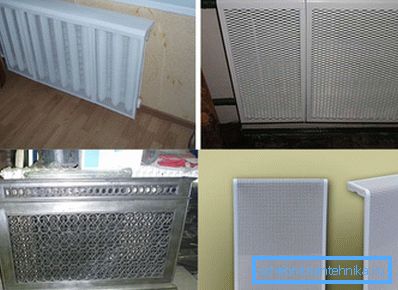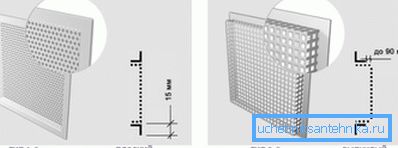What are and how are used metal screens for radiators
Modern rules for the design of premises, as well as growing security requirements, recommend limiting access to heating devices or at least partially blocking them.
Therefore, various types of screens have been developed, including those made of metal, which can be used both as a decor and as protection against accidental contact with them. In addition, they can be used to design other elements of the heating system, as well as to partially disguise some unwanted parts in the room.

Metal screens for batteries are characterized by a complete and ready-to-install design that corresponds to most of the standard sizes of these products. The industry offers models for heating devices not only of the new model, but also of the old ones, made of cast iron, steel and aluminum. Their price depends on the size and type of product.
Where to use them
When decorating or finishing a room, a situation may often arise when installed old heating devices do not fit into the new interior and spoil it with their appearance. In this case, it will be quite expensive in their total or partial replacement, therefore, metal screens were developed to hide the lack of aesthetics of such products.

With their help, it is possible to block the view of the front surface of the radiator, the top and end surfaces. However, there are also structures that allow the creation of single, extended ceilings along the walls consisting of several decorative screens for radiators of the heating system, which allows them to be used as an independent decorative element.
Why was it customary to apply a battery fence? This is due to the very high temperature of heat transfer fluids in heating devices, which can especially become dangerous in kindergartens, administrative and educational buildings, medical cabinets. Designed metal screens for radiators in this case are mandatory in order to prevent accidental contact with their hot surface.

Their special application can be found in rooms where there are complex inputs of highways, openings and niches, ventilation channels and other similar elements.
Such sections of metal screens of the following structures overlap in whole or in part:
- in the form of a flat panel;
- with the top open or deaf plane;
- with side and top planes;
- in the form of boxes. (See also the article Pipe box: features.)
Tip: you can use them in separate structures and installations that require overlapping holes and aisles with the circulation of air masses.

Kinds
Metal screens for heating devices are made with:
- different structural elements;
- additional structures of various types;
- full or partial overlap in planes;
- different design of the front surface.
It is not difficult to install them yourself.
Design differences
- Fastening system and lattice part:
| Fastener | It can be represented by the following construction:
|
| Lattice | It can be made in several versions, but most often it is:
In this case, the latter can be in the form of a woven mesh, the base of which is represented by individual metal rods with different cell sizes. |

- The presence of the upper and end planes with or without their own mesh inserts:
- the first can be made in a removable version or be made from one with the front panel of the sheet;
- the latter are made with regard to the supplied pipelines and can have ready-made spaces for them or prepared holes that are easy to make.
Some models allow you to connect multiple faceplates into a single design using end plate anchorages. In this case, it is possible to make a metal screen for radiators of large or non-standard length.
Tip: using prefabricated structures, you can install products along the entire wall so that they immediately block the batteries and the pipelines connected to them.

Product Features
Screens for metal radiators, although simple in design, have several mandatory characteristics. Thanks to this, it is possible to mount them on radiators and operate for a long time without changing the parameters.
Consider these characteristics in more detail:
- standard size - is selected according to the size of the heating device being designed;
- strength - ensures the preservation of the geometry and position after a small mechanical load;
- heat resistance of coating - its properties and color should not change under the action of high temperature;
- required grid capacity - after using the metal screen, the instruction requires that the air circulation around the radiator does not decrease;
- possibility of quick dismantling of the whole structure or its individual parts when carrying out repair and maintenance work.
Conclusion
Metal screens for heating radiators are a simple universal product, which allows to exclude most undesirable situations. With their help, it is possible not only to disguise some parts of the walls, but also to protect people from accidental contact with the hot elements of the heating system.
Currently, such structures are used in many rooms, which indicates their simplicity and affordability. The video in the article will help you find additional information on this topic.